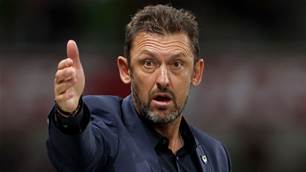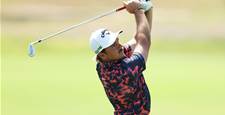Tactical analysis of Australia's vital victory in Adelaide
Ange Postecoglou persisted with the pendulum back three as the sometimes-erratic Socceroos recorded a vital 3-2 World Cup qualifying win against a very impressive Saudi Arabia on Thursday night.
The system was introduced in March for games against Iraq and the UAE. But in Adelaide, Saudia Arabia boss Bert van Marjwick sent his team out to take the game to Australia - when it had been widely predicted that they would opt to sit deep and absorb pressure instead.
Formations
Midfield duo Tom Rogic and Aaron Mooy started for Australia, as well as fellow English Championship colleagues Mile Jedinak and Jackson Irvine. Brad Smith was selected over clubless Robbie Kruse, while Ryan McGowan was positioned as right centre-back. Tomi Juric led the line. For the Saudi’s, Nassir Alshamrani was left out of the XI, which included a return for Salem Al-Dawsari. 33 year-old captain, Osama Hawsawi, led from the heart of defence.

Australia pressing from the front
Whilst the back three of Degenek, Sainsbury and McGowan looked vulnerable in parts of the first half, it can be said that Australia’s pressing from the front was generally of a very high standard. The initial press of double goal-scorer Tomi Juric dictated the direction of ball circulation, which allowed the Australian midfielders to slide across and form a high block to prevent Saudi progression through the lines. With the prevention of vertical progression as a clear objective, the Socceroos engaged in a man-oriented defensive scheme as they looked to restrict the options of the player on the ball, such as Abdulla A-Zori in Figure 2 below. Without possession, the opposite winger would drop off onto the third line when the ball was in the Saudi Arabia defensive third, before acting as a conventional full-back in more threatening circumstances. In this case, it can be seen that Brad Smith has dropped to be on the same horizontal line as the centre-backs.

With this in mind, the five remaining midfielders repositioned towards the right-hand side of the pitch; Rogic and Irvine pressed the two holding midfielders, Leckie covered Al-Sheri, and Mooy and Jedinak alternated between marking Al-Jassam and protecting the space in front of the back three. On occasion, the Australian players would position themselves ball-side to their man, employing cover shadows in order to restrict the ability of Saudi Arabia to play to feet, which often lead to a pass backwards or a loss of possession. This strategy proved to be successful over the course of the game, with the Socceroos consistently winning possession in advanced areas of the pitch.
The national team has often been criticised for failing to properly engage the pace of Hertha-bound Mathew Leckie, and it appears as if a potential solution to the problem has been found.

As a direct consequence of this action, Juric was afforded the opportunity to put Australia in front for the second time, so it can be said that the move proved to be highly effective. When playing out from the back in deep positions, Tom Rogic and Jackson Irvine began virtually all movements from the horizontal line of the Saudi back four. The space between the lines was targeted, and Rogic particularly would often receive the ball facing the opposition’s goal and drove toward the half-space. In doing so, he invited the left-back to press, creating space in behind the back four for Leckie to exploit. This is an example of the value of players who can intelligently run with the ball, wherein the trajectory can alter the shape of the opposition, leading to the creation of space in areas which are usually protected. The half-space also represents an ambiguous area to defend, as it is unclear as to which defender is responsible for pressing the ball carrier. More often than not, the centre-back will prioritise maintaining security in the central zone, with the implication being that the full-back must press – leaving the wider channel open.

Saudi Arabia’s use of cover shadows
At many times throughout the match, Australia’s back three looked shaky when in possession. Saudi Arabia’s defensive strategy, which included the intelligent use of cover shadows, contributed to this perception as passing options into midfield were controlled by the front three of Al Sahlawi, Al-Dawsari and Al-Shehri. As it was essentially a 3v3 situation, Saudi Arabia were able to opt for a man coverage system, whilst measuring their runs to ensure Mooy and Jedinak were not in a viable passing line. The front three, as pictured below, were able to cover each member of the Australian back three individually, with the spare man of Mooy or Jedinak being able to be covered by advanced midfielder Al-Jassam. The two holding midfielders were then able to screen Australia’s Rogic and Irvine, with the relevant full-back stepping up on one of Leckie or Smith/Behich, depending on which side the ball was on.

As seen above, this aggressive strategy ensured difficultly in progression for Australia, often allowing the Saudi’s to start their attacks from positions close to Mat Ryan’s goal. On occasion, Trent Sainsbury was able to break the first line of pressure by playing a ball to the feet of Mooy or Jedinak, who were then able to act as the foundation of the subsequent sequence of possession.
Exceptional KSA combination play
In the latter stages of the first half particularly, Saudi Arabia put on a lesson in combination play. In order to escape the aggressive of Australian press, the Saudi’s would play a series of one touch passes and ultimately change the direction of play. Then, after a sustained sequence of slower passes in wide areas, Mooy and Jedinak would be drawn across to assist in regaining possession – at this point, it is important to note that there are only two ways of beating a player; a change of speed or a change in direction. Once the holding midfielders were pulled away from the space they were initially defending, Al-Jassam positioned himself between the lines, which triggered an extraordinary change of pace. A vertical ball was played into the space, and Al-Jassam repeatedly found himself driving towards the back three of the Socceroos.

This principle factored into both Saudi goals, and was a hallmark of their overall play throughout the game. Again and again, they escaped the press with one-touch passing, drew players out of position with slower, more sustained possession and capitalised on the created space by quick circulation.

Conclusion
Overall, both teams attacked with fervour and the match saw many chances not converted. A dominant spell from Saudi Arabia made Australia look second best, which would have no doubt continued had Postecoglou not brought on the more attacking-minded Behich, who was able to disturb the build-up play of the Saudi’s much more effectively than Brad Smith. There is much more work to be done for Ange and the Socceroos, who will be encouraged by their second half performance but will be equally mindful of a nervous and erratic first period. Nevertheless, it will be seen as three valuable points, as confidence builds in terms of securing automatic qualification to the 2018 World Cup in Russia.
Related Articles

Champion A-League coach set to join Premier League giants

Split decision: Popovic in mix as Hajduk hunt new boss












